Knowing how to start a presentation is a crucial skill in today’s professional landscape.
After all, many office workers are called on to prepare a presentation at some point during their careers.
And, of course, many people are looking to share their expertise through workshops and lectures.
With that in mind, we wanted to dedicate an article to learning about the best ways to deliver an impactful presentation opening.
So, whether you’re currently struggling to come up with introductory lines for a presentation, or you have a more passive interest in this subject — you’ve come to the right place.
In this article, we’ll:
- Share expert tips for preparing the best opening lines for any type of professional presentation,
- Offer some valuable examples and specific phrases you can use, and even
- Analyze the way professional speakers approach their presentations.
But first, let’s talk about why having a good introduction is such a crucial part of any presentation.

Table of Contents
Why does having a good introduction to a presentation matter?
If you’ve ever had to prepare an address, you probably understand the importance of having an impactful introduction to a presentation.
If the body of a speech contains most of the information you want to share with the audience and the conclusion allows you to invite the audience to take action — the introduction is how you get them to listen to you in the first place.
In other words, a presentation is a motivated sequence — a method of persuasion with 5 distinct steps:
- Attention — wherein the speaker introduces the problem the listeners are having in an interesting manner. In the format of a presentation, this step is the introduction.
- Need — the speaker explains how the problem affects the listeners and backs up their claims. This step corresponds with the body of a presentation, along with the following two.
- Satisfaction — the speaker offers a solution and shows how it will alleviate the concern they have previously identified.
- Visualization — the speaker describes precisely what will happen if the listeners choose to implement their solution. Sometimes, they also describe what will happen if their solution is not implemented. This concludes the body of the presentation.
- Action — the speaker directs the listeners with a call to action, explaining what they can do in response to their presentation. This step represents the conclusion of a presentation.
Even though this framework was developed in the 1930s, it’s still a useful tool for people who want to improve their presenting skills.
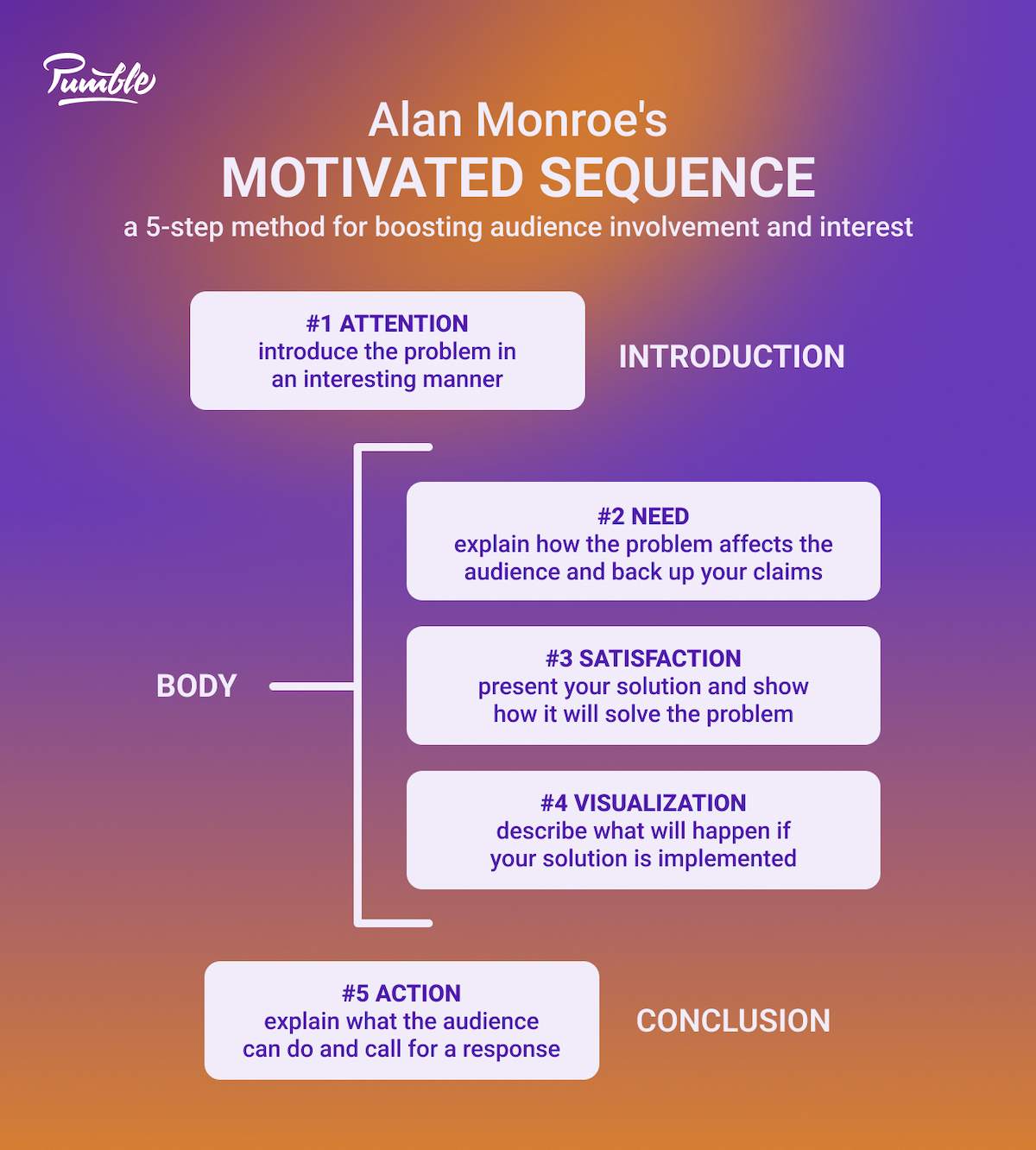
What do professional speakers have to say about the importance of opening a presentation effectively?
For more insight into the importance of starting a presentation with a bang, we turned to professional speakers and communication experts.
We put the question to Mark Beal, Assistant Professor of Professional Practice, Communication, at Rutgers University School of Communication and Information. Here’s what he had to say:

“It is critically important to engage your audience immediately at the start of a presentation in a high-energy manner, or you could lose them to their mobile phone or laptop and you may never get them back.”
Speaker, author, communication skills trainer, and editorial producer at CNN, Nadia Bilchik, added:

“The beginning of your presentation is your prime real estate. It’s when your audience decides if you are worth paying attention to or not.”
So, in addition to capturing the audience’s attention, your introduction also needs to establish your authority.
Having said that, let’s talk about the specific steps you need to take before you begin presenting to make your presentation opening as memorable as it can be.
How to prepare the best opening for a presentation
Before we tell you how to start a presentation speech, let’s take a moment to consider the best preparation practices.
Naturally, preparing the introductory lines for your presentation should take place well before the speech itself.
Even so, many novice speakers are still unaware of the different factors that should influence and inform their decisions in this regard.
Luckily, we have managed to boil the results of our extensive research down to the following 3 tips:
- Take note of the way other people start their presentations,
- Understand the goals of an introduction, and
- Know your audience.
Having said that, let’s see what each of those tips entails.
Tip #1: Watch other speakers’ openers
As Napoleon Hill, author of Think and Grow Rich, puts it:
“Experience has taught me that the next best thing to being truly great is to emulate the great, by feeling and action, as nearly as possible.”
With that in mind, the best thing you can do before drafting your speech is observe the way others have made theirs.
In this case, you’ll want to focus on the way professional speakers introduce themselves and the subjects of their presentations.
The goal of this exercise is to determine:
- What makes a good opening statement,
- Which openers are generally effective with audiences, and
- What kinds of introductions you resonate with.
Somewhere in the middle of those categories is where you’ll find the opening lines of your presentation.
For their part, the experts we have contacted seem to agree with this tip.
Nadia Bilchik said:

“I have been speaking and training speaking skills for three decades and I still do a tremendous amount of research and customize each and every presentation. If I am speaking […] about the hybrid workplace, I will Google [the] latest statistics. I will also go onto YouTube to see what other speakers and thought leaders are saying about the subject.”
And Mark Beal mirrored her thoughts:

“I am consistently studying presentations in a quest to be a student who is always learning, evolving, transforming, and innovating my approach to presenting. I closely watch all types of presentations, from TEDx Talks to my former students who return to guest lecture in my university courses.”
Tip #2: Understand the goals of an introduction
According to the other authors of Communicating at Work, an introduction has 5 distinct objectives. It should:
- Capture the listener’s attention (or, as professional speakers might say, “hook” them),
- Give them a reason to listen (offer a solution to a personal or professional problem they have),
- Set the proper tone for the topic and setting (let the audience know whether they’re in for an informative, emotional, or humorous speech),
- Establish your qualifications (explain why the audience should listen to you, specifically), and
- Introduce your thesis and preview your presentation (so that the audience knows what to expect in advance).
With those goals in mind, Nadia Bilchik would even say that:

“It’s always best to have someone else introduce you and confirm your credibility.”
That puts the onus of explaining why you deserve to be there on the host of the meeting and allows you to skip that part of the introduction.
However, these 5 objectives are not a checklist you have to follow at all costs.
Depending on the circumstances surrounding your presentation, some of them will matter more than others.
Speaking of, there’s one last thing to keep in mind when crafting your presentation opening.
Tip #3: Know your audience
The audience you end up presenting to will affect everything from the way you organize your presentation to your style of delivery — and even the supporting materials you use.
Your presentation’s opening lines are no exception.
In other words, the content and style of your introduction will depend on the size of the group you’re speaking to and its demographic breakdown.
However, perhaps the most important audience attribute you’ll have to keep in mind is its willingness to listen and engage with your message.
In Business Communication: Process & Product, authors Mary Guffey and Dana Loewy have identified 4 types of audiences based on that factor:
- Friendly — an audience that likes you and cares about your topic,
- Neutral — an audience that is calm and considers itself objective,
- Uninterested — an audience full of people with short attention spans (who may or may not be there against their will), and
- Hostile — an emotional or defensive audience whose goal is to take charge or ridicule the speaker.
Luckily, Guffey and Loewy have also provided some guidance for dealing with each of those kinds of audiences.
| AUDIENCE TYPE | DO | DON’T |
|---|---|---|
| FRIENDLY | – Be warm and pleasant – Include humor and personal experiences – Involve the audience – Try something new | / |
| NEUTRAL | – Be confident – Use subtle gestures – Use facts, statistics, and expert opinions – Present both sides of an issue – Save time for audience questions | – Do anything showy – Use humor or rely on personal stories – Show flashy visuals |
| UNINTERESTED | – Be brief — no more than 3 points – Be dynamic and entertaining – Move around and use large gestures – Fall back on humor, cartoons, colorful visuals, and interesting statistics | – Bore the audience – Darken the room – Stand motionless – Pass out handouts – Use boring visuals – Expect audience participation |
| HOSTILE | – Be calm and controlled – Speak evenly and slowly – Stick to objective data and expert opinions | – Use personal examples and humor – Allow Q&A segments without a moderator |
How to start a presentation effectively (tips + examples)
It’s the day of your big presentation — time to go big or go home.
Which of the following tips would you incorporate in your presentation opening lines?
- Exude confidence.
- Drop the pleasantries.
- Prove your expertise.
- Begin with a realistic promise (explain what the audience stands to gain from your presentation).
- Go for the drama.
- Fall back on an insightful quote or a pop culture reference.
- Share an interesting statistic.
- Ask questions.
- Relieve tension with a joke or a humorous statement.
- Use visual tools (like images, videos, or props).
If you haven’t thought about which one of these would help you get your point across effectively — don’t worry.
We’re about to explain each of those tips and provide some illuminating examples and specific phrases you can use when starting a presentation.
Tip #1: Exude confidence
One thing you need to know about starting a presentation is that your work begins the moment you set foot on that stage.
Alternatively, it begins the moment someone passes you the (literal or figurative) mic — if we’re taking into account the presentations that take place on video conferencing platforms.
In any case, you’ll want the audience to see you as someone who knows what they’re talking about. That includes:
- Making eye contact,
- Moving with intention (not fidgeting),
- Wearing professional attire (or at least appropriate attire for the occasion),
- Projecting your words, and
- Showing your confidence through nonverbal cues.
One of the experts we spoke to, Reesa Woolf, PhD, keynote speaker, bestselling author, and executive speaking coach, would even advise you to rehearse your opener and closer to the point of being able to “deliver them with 100% eye contact.”
For what it’s worth, overpreparing also allows you to appear more confident when presenting, as you’ll be less worried about forgetting parts of your speech.
Then again, a moment of forgetfulness can also be turned into a tool for establishing a commanding presence.
Namely, staying still or being quiet for a moment can make the audience pay closer attention to you.
But, if that’s something you’d like to try, make sure the technique doesn’t clash with the type of audience you’re presenting to.
Tip #2: Drop the pleasantries
Have you ever heard a professional public speaker use one of these phrases?
- “It’s a pleasure to be here.”
- “I’m honored to be asked to speak about…”
- “Today, I’m going to talk about…”
The chances of a professional using these phrases are pretty slim — so why would you?
Well, there’s nothing wrong with following a traditional format to introduce yourself.
However, you’ll have to admit that the sentences we have listed above don’t pack the same punch as some of the other presentation opening lines we have included in this article.
Keynote speaker, Forbes contributor, career change consultant, and host of the Career Relaunch® podcast, Joseph Liu, recommends avoiding greetings altogether.

“While I do say hello, rather than starting with drawn-out greetings, I recommend diving right into the presentation with a hook so your audience immediately switches on to the content you’re about to present.”
Speaker, bestselling author, and award-winning accountant, Tatiana Tsoir, notes:
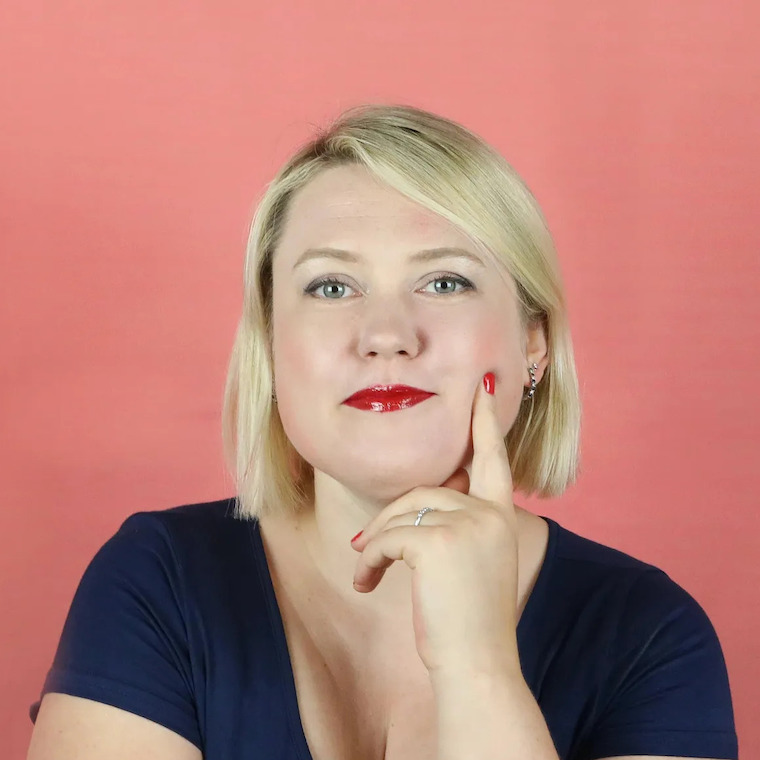
“People’s attention span is 20 minutes max, which is why TEDx is capped at 18 min. Also, people generally remember the beginning and the end, so make sure those are strong [and] get to the point fast.”
So, instead of wasting time on small talk, use an opener that will get your audience’s attention as quickly as possible.
💡 Pumble pro tip
Even though the examples we have listed would be considered a weak way to start a speech, some of them are ideal for starting a business meeting. If you want to know some other expressions that might come in handy in that kind of setting, check out this article:
Tip #3: Prove your expertise
As we have established, starting a presentation with a traditional introduction may not be the best way to get the audience’s attention.
Still, you’ll have to establish your credibility at some point — so we might as well illustrate how to do so properly.
Of course, if you’re a teacher or an educator in broader terms, you probably won’t have to prove your expertise to your audience.
However, if you’re tasked with presenting in front of neutral or hostile audiences, you’ll want to establish your qualifications as soon as possible.
If you can’t get someone else to introduce you and establish your credibility before you start your presentation, we suggest hooking the audience first and then introducing yourself right before you head into the main part of the speech.
Phrases you can use to establish your credibility
We have come up with 3 imaginary presentation scenarios to help illustrate our points throughout this guide.
Here’s how our speakers might introduce themselves:
“Hello, everyone. For those of you who don’t know me, I’m Nick Mulder, the head of the security department. I’m here to talk to you about phishing.”
“My name is Joan Miller. As someone with over four decades of experience in marketing, I’m uniquely qualified to talk to you about how artificial intelligence is changing the future of the industry.”
“I’m Milo Green — you probably know me as being the founder of Green & Co. As someone who’s had a hand in running a successful business for over two decades, I’m here to explain how my company’s employee retention rate has never fallen below 85% in a single year.”
If these speakers started with a hook rather than an introduction, the sentences introducing the subject of their presentations would be excessive.
Tip #4: Begin with a realistic promise
So far, there’s been a lot of discussion about “hooks” in this article and not many specific examples of phrases that might hook an audience — let’s change that.
The first type of hook you might want to master, especially for professional presentations, is the “promise.”
One of the experts we have spoken to, Reesa Wolf, uses that very method:
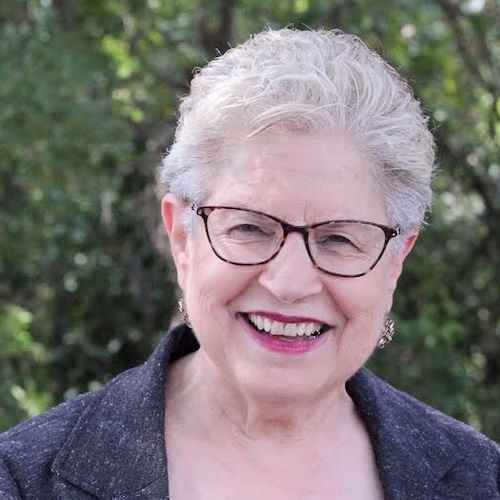
“Begin with a brief statement about the benefits of listening to [your] message. You can give an example of a company or person like them that had the issue they have and how these ideas solved it, but it still must be brief.”
In other words, start by giving them a preview of the knowledge they’ll have by the time you finish your presentation.
This method of starting a presentation is a great way to:
- Show that you’re in tune with the listeners’ needs, concerns, and interests,
- Offer a solution to a problem the audience might have, or
- Keep the audience interested throughout your presentation.
Ultimately, audiences are self-interested — they will listen to you if you explain what’s in it for them.
Usually, that will require you to point out a problem they are having or an opportunity they’re not taking advantage of.
Phrases you can use to offer a realistic promise
To put this tip in perspective, let’s hear from our imaginary presenters:
“By the end of my talk, you’ll be able to spot phishing emails and understand the steps you need to take when you do.”
“My presentation will alleviate any worries you might have about the ways the marketing sector will need to adapt to the AI revolution.”
“During this talk, you’ll learn how your company can improve its relationship with its employees and boost its retention rate.”
Tip #5: Go for the drama
One thing you should note as you are writing your presentation opening is that the first words you say will set the tone for the rest of your speech.
If offering a realistic promise to your audience suits your presentation subject — by all means, do so.
However, if you’d like to induce excitement and keep your audience’s mood elevated throughout your presentation, you might want to go for a more dramatic entrance instead.
Namely, you could start with:
- A fun fact,
- A startling statement, or
- An emotionally moving story.
Many speakers rely on these kinds of openers to establish the central theme of their presentation naturally.
After all, this method can make the speaker look more approachable and relatable, particularly if their opening line references other people (e.g. “the other day, I met someone/a coworker told me…”).
One example of this technique comes from author, entrepreneur, and certified fraud examiner, Pamela Meyer, who famously started her TED Talk by pointing to an audience member and saying:
“Okay, now, I don’t want to alarm anybody in this room, but it’s just come to my attention that the person to your right is a liar. Also, the person to your left is a liar! Also, the person sitting in your very seat is a liar.”
The combination of starting her speech with such a shocking statement and pointing out a specific audience member makes Meyer’s TED Talk an iconic one in our books!
Phrases you can use for a dramatic opening
Now, let’s see how our imaginary speakers would apply this tip:
“1,270,883! What do you think that number signifies? If you guessed ‘the number of phishing attacks recorded in the third quarter of 2022’ — you’d be right! We have the Anti-Phishing Working Group to thank for that disturbing piece of trivia.”
“Artificial intelligence is coming for our jobs! At least, according to Chat GPT and Business Insider, people working in tech, media, law, and many other industries might want to look elsewhere for employment in the coming years.”
“When I first started my company, I did it with about 20 of my most trusted friends and advisers. I’m happy to report that all but two are still working for Green & Co. — and those two are only absent because they’ve started their own successful ventures! In any case, my wish to surround myself with high-quality people has manifested itself in the company’s high employee retention rates. Today, I’m going to tell you about how I created an environment that makes employees want to stick around.”
Tip #6: Fall back on a quote or a pop culture reference
When in doubt, you could always start the introduction to your presentation with a quote.
As long as you don’t overuse other peoples’ words in your speeches, quotations are a completely legitimate and convenient tool for introducing the topic you’ll be discussing.
Aside from being a tried and true method of getting people’s attention without having to string together a perfect sentence on your own, quoting a particularly impressive individual is a good way to “borrow” their authority.
However, that can also be a double-edged sword, since it can also give you the individual’s notoriety. So, make sure you know whose words you’re echoing.
Of course, some people would advise you to avoid quotes altogether.
Assistant Professor of Rhetorical Communication at the State University of New York, Dr. Lee M. Pierce, cautions against starting your presentation “with quotes or long personal stories.”
Doing so might bore the audience.
Then again, Dr. Pierce also enjoys using pop culture references as openers, saying:

“By choosing a pop culture reference that most of your audience gets, you build instant rapport and have something you can use to ease them into your presentation material.”
So, perhaps there’s still a way to work a quote into your presentation, as long as it fits the mood you’re trying to establish.
💡 Pumble pro tip
If your presentation happens to be about team communication or collaboration, you may find the perfect quote to use in your introduction in one of these articles:
Phrases you can use when you’re opening with a quote
So, how would our three fictional speakers incorporate quotations in their opening lines? Let’s find out.
“According to Harper Reed, entrepreneur and Chief Technology Officer for Barack Obama’s re-election campaign, ‘Very smart people are often tricked by hackers, by phishing.’ So it’s not about being smart. It’s about being smarter than a hacker.’ And I’m here to help you get there.”
“Stephen Hawking once said that ‘Success in creating AI would be the biggest event in human history. Unfortunately,’ he said, ‘it might also be the last, unless we know how to avoid the risks.’ I’m here to alleviate your concerns about those risks.”
“When I was developing my management style, I often referred back to one particular quote by Max DePree, founder of Herman Miller. He said, ‘The first responsibility of a leader is to define reality. The last is to say thank you. In between, the leader is a servant.’ That sentiment clarified my function for me — even though I was the CEO of my company, I was primarily there to help my employees.”
If you want to make sure your audience understands what you’re talking about, you could also show the quote on the first slide of your presentation.
Tip #7: Share an interesting statistic
Using relevant, interesting statistics is another great way to introduce the topic of your presentation.
This tip could also be an excellent tool for establishing your qualifications, if you decide to share a statistic that proves the efficacy of the solution you’re presenting.
Just keep in mind that people tend to trust third-party sources more than a potentially unverifiable statistic coming from your organization’s internal research.
Phrases you can use to introduce your presentation with a statistic
Let’s see how our three presenters might incorporate this tip.
“According to APWG, the number of wire transfer Business Email Compromise (BEC) attacks increased by 59% in the third quarter of 2022.”
“Netflix took 3.5 years to reach a million users. Facebook took 10 months. ChatGPT, which has been dubbed the best AI chatbot ever released by New York Times, reached its first million users in only 5 days. By January 2023, over 100 million people had used the service.”
“According to the 2022 Workplace Learning Report from LinkedIn Learning, companies that enable their employees to advance internally retain employees for an average of 5.4 years. That’s nearly twice as long as companies that struggle to provide opportunities for internal mobility, where the average retention span is 2.9 years.”
And, if you wanted to go the extra mile, you could also represent the statistics you’re talking about with a visual element.
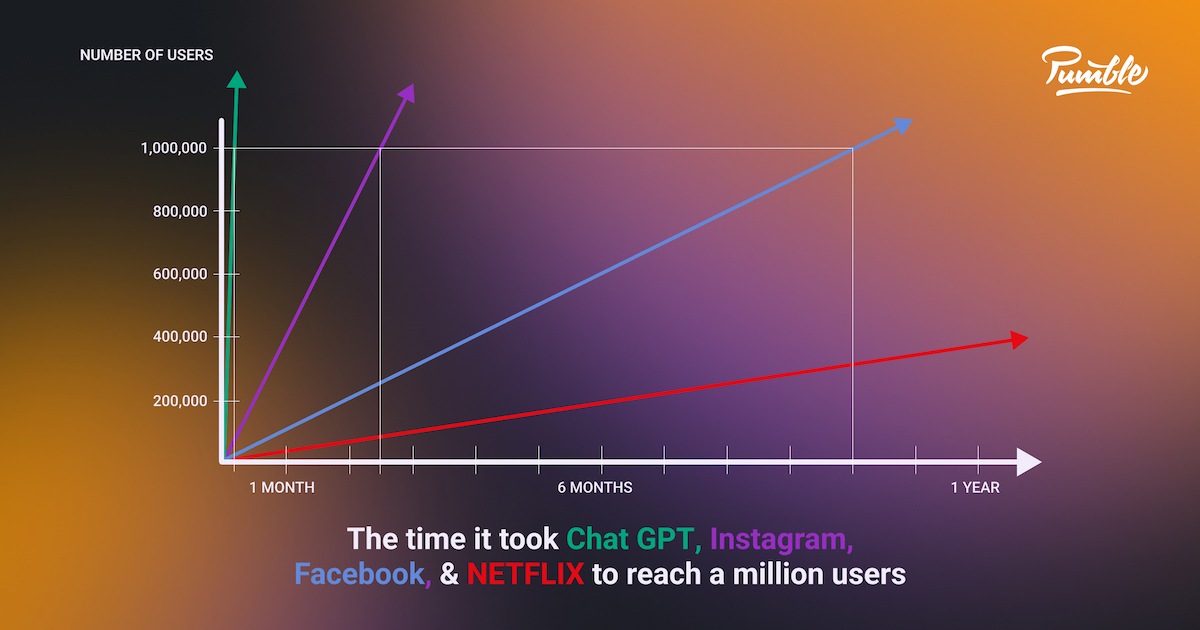
Tip #8: Ask questions
Once you start researching public speakers, you’ll find that many of them engage their audience by asking questions.
It goes back to the concept of “hooking” your audience. According to Joseph Liu:

“The best way to start a presentation is with a hook. For example, ask a question. Invite people to do something. Have your audience imagine a situation. Or, surprise them with an interesting fact.”
Indeed, most of the experts we have spoken to would confirm that questions are the best tool for increasing audience participation. As Nadia Bilchik would say:

“I like to ask my audience a question. […] the key is to invite participation from the start.”
With that in mind, there are 2 types of questions you can use, depending on the situation:
- Direct questions require answers from the audience. Speakers might ask for a show of hands or use a polling tool that allows people to stay anonymous while also showing the results for everyone to see.
- Rhetorical questions are about asking the audience to envision a scenario that allows you to introduce the topic of the presentation. These sometimes have a “What if” construction.
Either way, the questions should prompt the audience to start thinking about the subject of your lecture.
Questions you might use to open a presentation
Our resident phishing expert might ask his audience one of the following questions:
“How do you protect your company from phishing attacks?”
“Let’s see a show of hands — how many of you know what phishing is?”
“Has anyone here fallen prey to a phishing attack?”
Joan Miller, the digital marketer we have envisioned, might ask:
“Who here is already using AI to conduct their business?”
“Will your company survive the AI revolution?”
“Would you rather incorporate AI into your marketing strategy or continue doing business as usual? Think carefully about this question — and use the link I’m about to send you to tell me your answers. By the end of my presentation, I’ll run this question by you again, and we’ll see how the results of the poll have changed.”
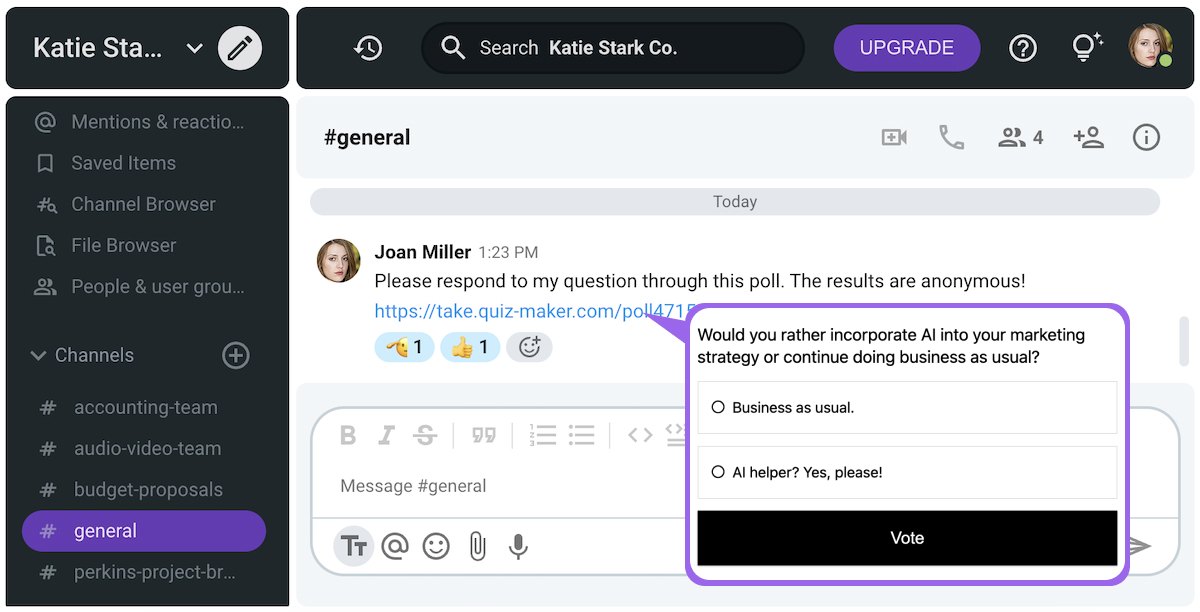
Lastly, our imaginary CEO might ask his audience:
“Does your company’s employee retention rate matter?”
“How are you making your company a desirable place to work?”
”Can anyone here tell me their company’s employee retention rate?”
Tip #9: Relieve tension with a humorous statement
If you sense that your audience isn’t in the mood to take in the kind of presentation you have prepared, you can prime them for it with humor.
Cracking a joke at the top of your presentation sets the scene for a lighthearted conversation and makes you appear confident (even if you’re not). Additionally, a well-placed joke can:
- Get the audience interested,
- Make a point about the topic of your presentation, and
- Increase your likeability.
But, humor is an art form — and not everyone has the talent and skill to execute this tip effectively. If it doesn’t come naturally, there’s no need to force it.
When in doubt, take a page out of the comedian’s playbook and run your opening joke by a friend or, better yet, a more neutral acquaintance.
Of course, even if your joke works on them, you can’t always account for cultural or even professional differences that might prevent some people in the audience from getting it.
Jokes for opening a presentation
The 3 speakers we have imagined might use the following jokes to kick off their presentations:
“Can anyone tell me a hacker’s favorite season? Phishing season, of course! Unfortunately, in real life, phishing season is more of a year-round kind of thing.”
“Why are people so nice to AI? Because it’s self-conscious! Just kidding. For now… Actually, I have good news and bad news. The bad news is that AI does seem to be gaining traction, particularly in the marketing industry. But, the good news is that I’m here to tell you how to navigate that situation.”
“Did you know that staff retention is more likely to be improved by offering better working conditions than by chaining employees to their desks? Much to think about!”
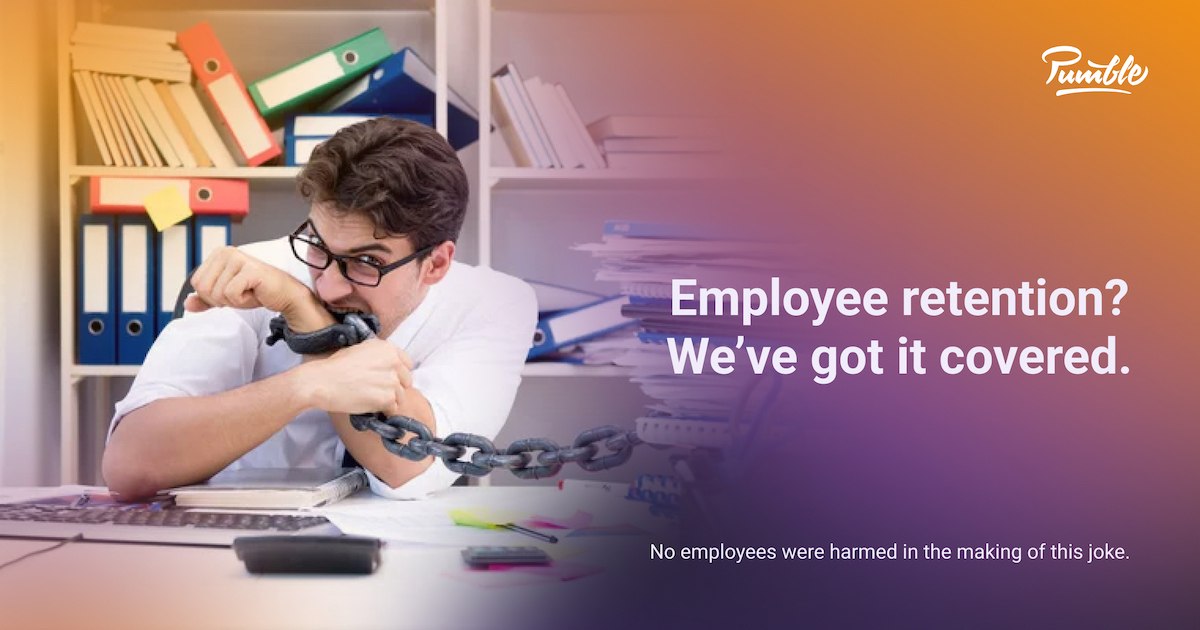
Most of these examples would pair wonderfully with a visual element — which brings us to our final tip!
Tip #10: Use visual tools
Different speakers have different approaches when it comes to the visual aspects of their presentations.
Some rely on their speech to get most of the information across. Yet, others prefer to make their presentation slides a more integral part of their presentation.
We imagine Joseph Liu would sort himself into the latter group:

“I tend to keep my presentations as visual as possible, relying less on quotes and more on imagery.”
If you decide to let visuals do some of the heavy lifting for your presentation, there are several ways to incorporate them. Namely, you could:
- Use images in your presentation slides,
- Invite the audience to watch a video before the presentation,
- Hand out printed materials,
- Show data charts, and
- Bring out a physical prop.
The type of visuals you end up using will depend on the type of presentation you’re giving.
Either way, you’ll want to become familiar with different elements of visual communication (such as colors, shapes, fonts, and layouts) if you want to make your presentation truly memorable.
💡 Pumble pro tip
Visual communication is one of 4 types of communication. If you’re curious about what the other 3 types of communication are and how we use them in our everyday lives, check out the following article:
Examples of visual tools opening a presentation
Going back to our 3 speakers, let’s see how they might incorporate visual elements into their presentation introductions.
“According to APWG, these are the most targeted industries for phishing scams in the third quarter of 2022.”
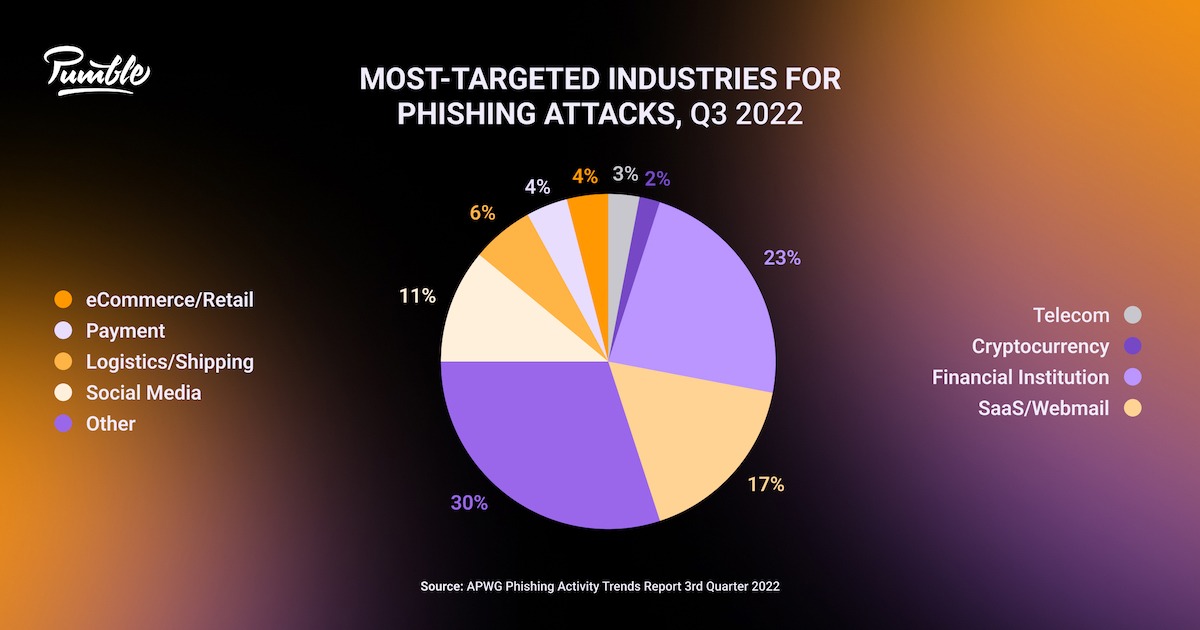
“The following demonstration of AI’s capabilities might change some of your outlooks on the future of marketing. I have shared my computer screen with you all, so let’s take a moment to see where this tech is at right now through a demonstration of the existing software.”
“Before I start my presentation, let’s look at a video showcasing the importance of having a high employee retention rate.”
You could also combine this tip with the others on our list, by saying something like:
- “Can anyone tell me what’s wrong with this picture?” thus, combining a visual opener with a question, or
- “What do you think the number on the screen behind me signifies? If you guessed ‘the number of phishing attacks recorded in the third quarter of 2022’ — you must be psychic!” as a spin on an example we used to illustrate tip #5.
Putting the tips into practice
Having concluded our list of tips, we wanted to see how the experts we have spoken to have put them into practice.
So, let’s start with the way they conceptualize and write their presentation starting lines.
Step #1: Draft your speech
Every memorable presentation starts with a written copy of everything you want to say.
According to Tatiana Tsoir:

“Developing a speech is a craft. I generally work first on who the audience is, then my core message I want them to walk away with, then the outline of the speech: how and when I introduce the main idea, and how I make a case for it and reiterate it throughout.”
Ultimately, the best time to write your presentation introduction would be once you have a clear idea of everything you want to say in the body and conclusion of your speech.
Even so, sticking to this advice won’t make you a better speaker immediately.
Instead, our experts have stressed that the only way to get better at presenting is through practice and repetition.
Take it from Tatiana:

“With public impactful speaking you don’t rise to the occasion, you fall back on training and practice.”
Step #2: Get right to the point
As you are drafting your presentation introduction, keep in mind that the audience is already waiting for you to get to the point.
When in doubt, follow Reesa Woolf’s formula for starting a presentation:

“Open with the attention-catching statement/story/quotation. Once they look at you, say your name and the parts of your experience and credentials that THEY would be most impressed by, at most 3 things about you.”
After delivering your opener and introducing yourself, you’ll want to quickly transition into the main part of your presentation.
Step #3: Invite audience participation
As we have previously mentioned, many of the experts we have contacted stressed the importance of increasing audience engagement.
Knowing your audience is a big part of that equation, as Dr. Lee M. Pierce would testify:

“Presentations should take advantage of what makes them unique — having an audience. Engage them, [and] introduce yourself. Just don’t start with a question right away — that’s asking too much too soon.”
Then again, many of the experts we have spoken to have said that asking questions is a good way to invite audience participation.
For example, Nadia Bilchik would even engage her audiences on a more physical level:

“I like to ask my audience a thought-provoking question. This gets them from passive to active mode. I also always get my audience to stand up and do a breathing exercise.”
Nadia also provided us with an example of an audience interaction she might use in the introduction of her speaking engagements. For example, she might ask the audience:

“How do you rate your ability to present information in a concise, clear, and confident manner? High, medium, or low?”
After receiving her answers by a show of hands or even an online poll, she connects the response to the topic of her presentation by stating:

“Wherever you are on the spectrum, in the next X minutes, I will share tips and techniques to ensure you have a greater impact every time you communicate to an audience of one or 100!”
That’s a textbook opener you can use to introduce the topics of your own presentation, too!
Step #4: Put it all together
Remember, nothing is stopping you from combining the tips we have mentioned throughout this guide to create a presentation introduction that is wholly unique to you.
If you’re unsure how to do that, let’s analyze a professional speaker’s technique.
Mark Beal told us about a presentation opening he’s created for his lectures:

“I start each of my Gen Z keynote presentations by physically walking off the stage and into the audience and asking a series of Gen Z trivia questions.
For those who answer the questions directly, I reward them with a copy of my latest Gen Z book. By taking this proactive approach, I physically engage the audience immediately not from the podium but in their seats.
My presentation instantly transforms from a one-way monologue into a two-way conversation and the audience begins to learn about my topic, Gen Z, in a fun and informative way.”
Can you connect the strategies Mark has used with the tips we have discussed? Let’s list them:
- Walking off the stage adds an element of drama and establishes a commanding presence,
- Asking questions engages the audience right off the bat,
- Rewarding the audience with a book promotes engagement throughout the presentation, and
- The books themselves are both an interesting prop and proof of Beal’s qualifications.
When you start researching famous speakers to prepare for your presentation, try dissecting the strategies they’re using.
Start your presentations right — With Pumble!
As you have seen above, it is crucial to conceptualize and think of your presentation’s starting lines.
To check if everything is fine, you can reach out to your colleagues via direct messages or dedicated channels and ask them for their opinions.
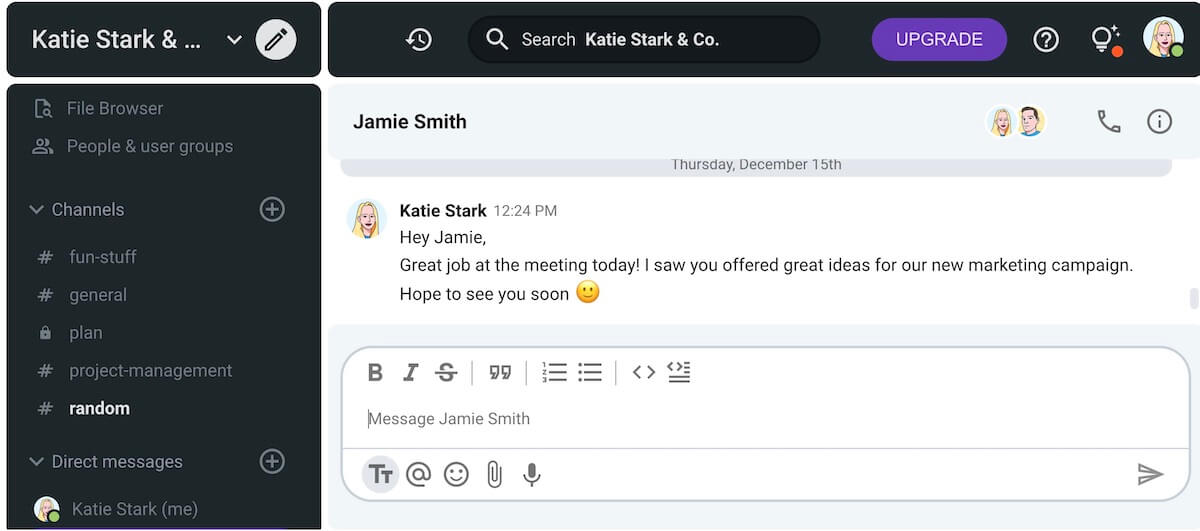
Your colleagues might provide some useful tips that will help you further improve your presentation in threads, just below your message or post.
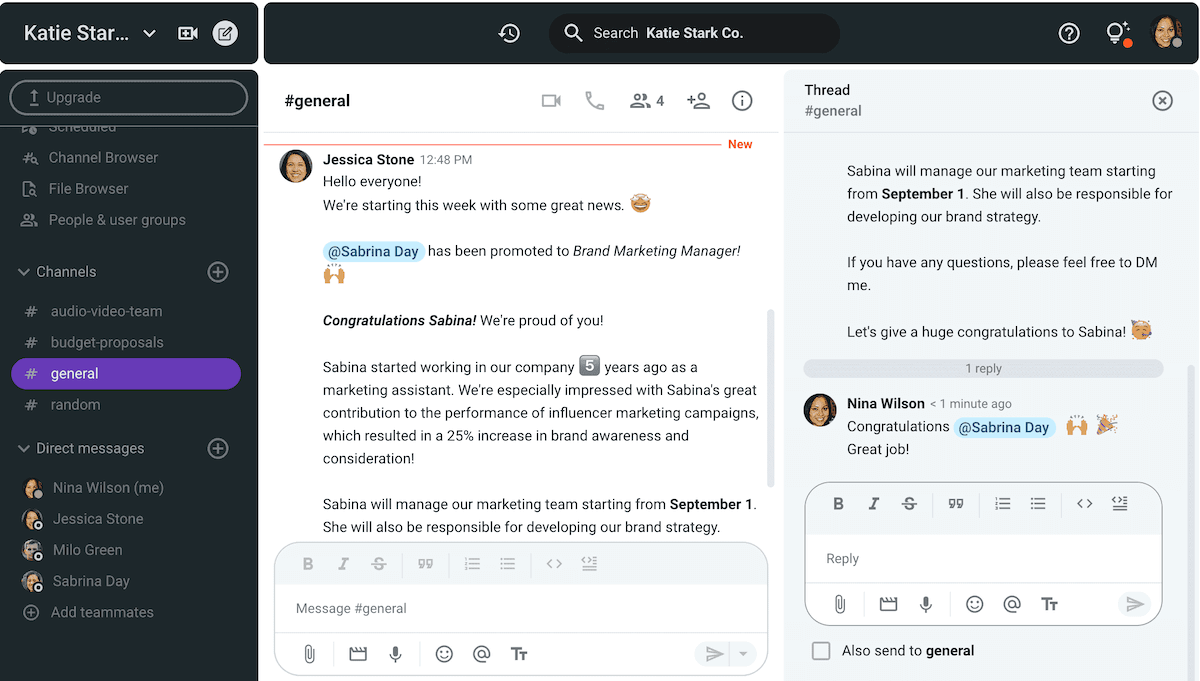
As Dr Lee M. Pearce pinpoints, having the right audience for the presentation is important. Hence, we recommend scheduling a video call so your closest colleagues and invited guests can see your new presentation and its opening lines, and provide suggestions, if necessary.
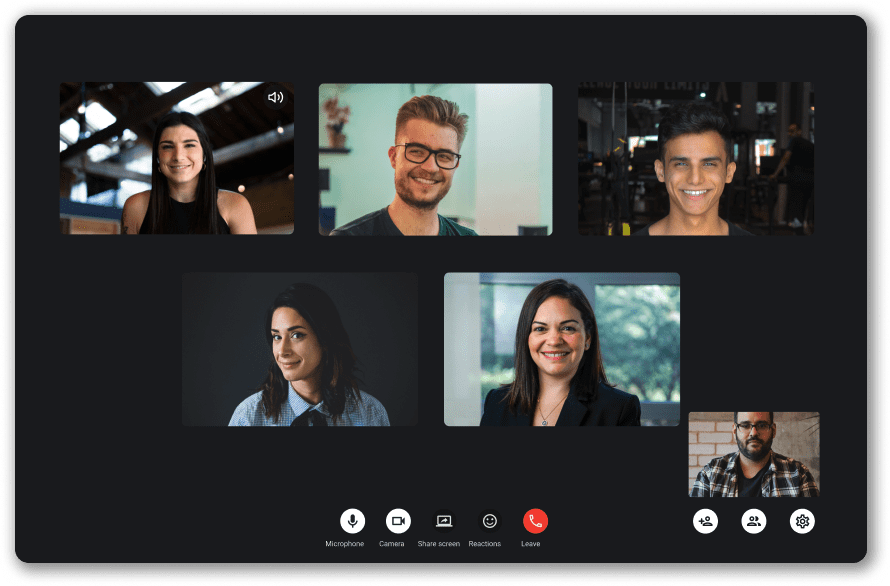
Of course, Pumble also comes in handy when it comes to holding presentations — thanks to its screen sharing feature that allows you to present to the entire meeting.
Finally, Pumble has an unlimited message history, so every message or file you have sent will forever stay in your message history. That might come in handy if you ever have to work on a similar presentation in the future.




